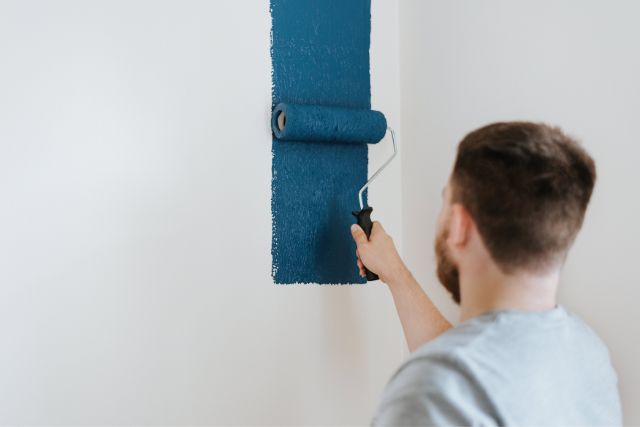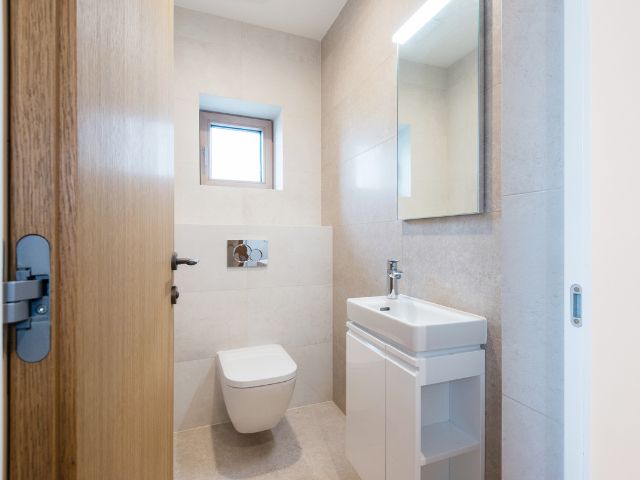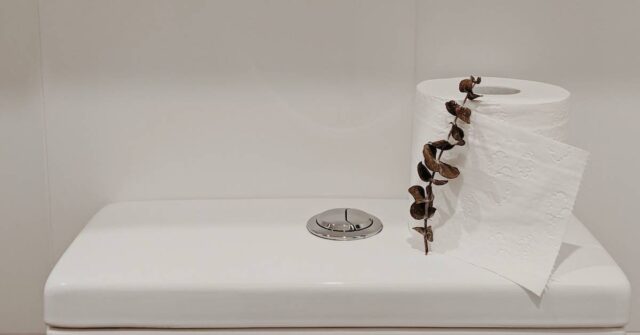When renovating a bathroom, many Sydney homeowners prioritize design and durability while often overlooking the health and environmental impacts of their choices.
Low VOC (volatile organic compound) paints offer a safer and more sustainable solution, making them a top pick for bathroom projects.
This guide explores why low-VOC paints are essential, especially in bathrooms, and how to choose the best options for your home.
What Are VOCs?
Volatile organic compounds (VOCs) are chemical compounds that easily vaporize into the air, often found in everyday products like paints, cleaning supplies, and adhesives.
These compounds contribute to indoor air pollution and can pose significant health risks over time. Understanding VOCs is the first step to making smarter, healthier renovation decisions.

Definition of Volatile Organic Compounds
VOCs are carbon-based chemicals that can evaporate at room temperature, releasing harmful gases into the surrounding air.
In the context of paints, these gases are emitted during and after application, leading to potential long-term exposure for household occupants.
Common Sources of VOCs in Homes
In most homes, VOCs come from a variety of sources, including traditional paints, varnishes, aerosol sprays, and even new furniture or flooring materials.
These emissions can accumulate indoors, creating an environment with poor air quality and potential health hazards.
Why Are Low VOC Paints Essential?
Low VOC paints are designed to minimize the release of harmful chemicals into the air. They are a healthier alternative to traditional paints, especially in enclosed spaces like bathrooms.
With improved air quality and reduced environmental impact, these paints are a must-have for modern renovations.
Impact of VOCs on Indoor Air Quality
Indoor air quality is directly affected by the release of VOCs. High levels of these compounds can lead to headaches, dizziness, and long-term respiratory issues.
Choosing low-VOC paints helps maintain a fresher, cleaner atmosphere in your home, making your living environment safer for everyone.
Health Risks of VOC Exposure
Prolonged exposure to VOCs has been linked to various health concerns, including eye, nose, and throat irritation, as well as more severe conditions like liver and kidney damage.
Children, elderly individuals, and those with preexisting health issues are particularly vulnerable. Low VOC paints help mitigate these risks.
Environmental Benefits of Low VOC Paints
In addition to improving indoor air quality, low-VOC paints have a smaller environmental footprint.
By releasing fewer pollutants, they contribute to a healthier ecosystem and support global efforts to combat air pollution and climate change.
Why Bathrooms Require Special Attention
Bathrooms are unique spaces in the home, with high humidity and limited ventilation. These conditions amplify the risks associated with VOC emissions, making it crucial to use safe, low-emission materials.
Low VOC paints not only protect your health but also perform well in these challenging environments.

Moisture and Ventilation Challenges
The humid conditions in bathrooms can exacerbate the effects of VOCs, as moisture facilitates the release of these compounds into the air.
Proper ventilation is essential, but pairing it with low VOC paints adds an extra layer of protection for occupants.
Confined Spaces and Increased VOC Exposure
Bathrooms are often smaller, enclosed spaces where VOC concentrations can build up quickly. This makes it even more important to minimize emissions by using paints specifically formulated for low VOC output.
Durability Requirements for Bathroom Paints
Bathroom paints must withstand high humidity, frequent cleaning, and potential water splashes.
Low VOC options are not only safer but also provide the durability and resilience needed for these demanding conditions.
Benefits of Using Low VOC Paints in Bathrooms
Low VOC paints offer numerous advantages that go beyond aesthetics. From health improvements to environmental gains, these paints are a wise choice for any bathroom renovation.
Let’s explore the key benefits that make them a standout option.
Improved Indoor Air Quality
By significantly reducing the release of harmful chemicals, low-VOC paints enhance the quality of the air you breathe.
This is especially crucial in bathrooms, where ventilation may be limited, and air circulation is often poor.
Reduced Health Risks for Residents
Families with young children, elderly members, or individuals with respiratory conditions can benefit immensely from low-VOC paints.
They help reduce the risk of irritation, allergies, and other health issues associated with traditional paints.
Eco-Friendly Renovation Practices
Using low-VOC paints is a step toward a greener future.
These products support sustainable living by emitting fewer pollutants, thereby reducing their overall environmental impact during and after application.
Compliance With Australian Standards
Australia has specific guidelines and standards regarding VOC levels in construction and renovation materials.
Low VOC paints align with these requirements, making them a responsible choice for homeowners and contractors alike.
How to Choose the Best Low VOC Paints for Bathrooms
Picking the right paint involves more than just selecting a pleasing colour. For bathrooms, it’s essential to prioritize paints that meet health, performance, and sustainability criteria.
Here’s how to make an informed decision.
Understanding VOC Levels and Labels
Low VOC paints are labelled with their VOC content, typically measured in grams per litre (g/L). Look for paints with VOC levels below 50 g/L to ensure minimal emissions and a safer indoor environment.
Top Low VOC Paint Brands Available in Sydney
Sydney homeowners have access to a variety of high-quality low VOC paint brands.
Popular choices include Dulux Low Sheen, Haymes EcoRange, and Resene Zylone Sheen, all of which combine safety with exceptional performance.
Key Features to Look For in Bathroom Paints
Bathroom paints should be moisture-resistant, mold-inhibiting, and easy to clean. Low VOC paints with these characteristics will not only improve safety but also extend the lifespan of your bathroom surfaces.

Balancing Cost, Quality, and Performance
While low VOC paints may come at a slightly higher price, their long-term benefits often outweigh the initial costs.
Consider the paint’s durability, ease of application, and eco-friendliness to find the best value for your investment.
Step-by-Step Guide to Painting Your Bathroom with Low VOC Paints
A successful painting project requires careful planning and execution. Follow these steps to transform your bathroom safely and effectively with low-VOC paints.
Preparing Your Bathroom for Painting
Start by cleaning the walls thoroughly to remove any dirt, grease, or mildew. Use painter’s tape to protect edges and fixtures, and ensure the room is well-ventilated during the process.
Choosing the Right Tools and Materials
Invest in high-quality brushes and rollers for a smooth application. Low VOC primers can enhance adhesion and durability, providing a flawless finish for your bathroom walls.
Applying the Paint: Best Practices
Apply the paint in thin, even coats, allowing sufficient drying time between layers. Follow the manufacturer’s instructions for optimal results and avoid overloading your brush or roller.
Post-Painting Maintenance and Care
Once the paint has dried, maintain its appearance by cleaning walls gently with non-abrasive products. Regular upkeep ensures your bathroom remains fresh and inviting for years to come.
Expert Tips for Maximizing the Benefits of Low VOC Paints
Experts recommend combining low VOC paints with smart practices to create a healthier, more efficient renovation experience. These tips will help you get the most from your bathroom makeover.
Ensuring Proper Ventilation During Application
Even with low-VOC paints, good ventilation is essential during and after application. Open windows or use fans to circulate fresh air and speed up the drying process.

Combining Low VOC Paints With Other Eco-Friendly Renovation Materials
Pairing low VOC paints with sustainable fixtures and materials enhances the overall eco-friendliness of your project.
Consider water-efficient taps, recycled tiles, and energy-saving lighting to complete the look.
Long-Term Maintenance for a Healthier Bathroom Environment
Regular cleaning and upkeep prevent mould and mildew, preserving the paint’s appearance and ensuring a safer, more pleasant space over time.
Frequently Asked Questions About Low VOC Paints
Still have questions? Here are answers to some common queries about low-VOC paints to help you make informed decisions.
What Are the Regulations for VOC Levels in Australia?
Australia sets strict standards for VOC levels in paints, with many products required to meet limits of 50 g/L or lower. These regulations aim to protect public health and reduce environmental harm.
Are Low VOC Paints as Durable as Traditional Paints?
Yes, many low VOC paints are as durable, if not more so, than their traditional counterparts. They offer excellent coverage and long-lasting finishes while being safer for indoor use.
Can Low VOC Paints Be Used in High-Humidity Areas?
Absolutely. Low VOC paints are specifically formulated to perform well in humid conditions, making them an ideal choice for bathrooms and other moisture-prone spaces.
Conclusion
Low VOC paints are a smart choice for anyone looking to create a healthier, more sustainable bathroom. They offer numerous benefits, from improved air quality to compliance with Australian standards.
Whether you’re a seasoned renovator or embarking on your first project, choosing low-VOC paints ensures a safer and more enjoyable experience for you and your family.





